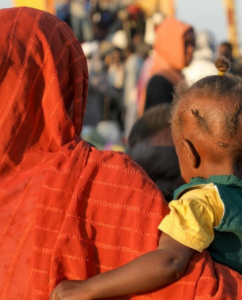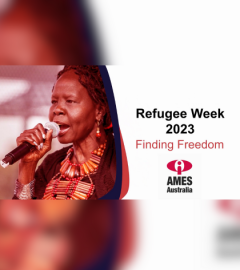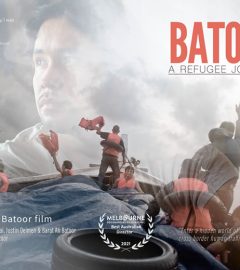Humanitarian aid cuts to devastate the lives of millions
As many as 11.6 million refugees and displaced people face losing access to direct humanitarian assistance from UNHCR this year because of major cuts to humanitarian budgets, and especially funding from USAID, the UN Refugee Agency UNHCR has reported.
According to the recently released ‘On the Brink’ report, the figure represents about one-third of those reached by the organisation last year.
It comes after a separate report published in the medical journal The Lancet says the Trump Administration’s move to cut most of the US’ funding towards foreign humanitarian aid could cause more than 14 million additional deaths by 2030, a third of them children.
The UNHCR report highlights a deadly confluence of factors affecting millions of refugees and displaced people: rising displacement, shrinking funding and political apathy. And women and children are, as ever, the hardest hit.
Altogether, $1.4 billion of essential programs are being cut or put on hold, according to the analysis of UNHCR programs and funds received this year. Millions now face deteriorating living conditions, heightened risks of exploitation and abuse, and may be pushed into further displacement.
“Behind these numbers are real lives, hanging in the balance. Families are seeing the support they relied on vanish, forced to choose between feeding their children, buying medicines or paying rent, while hope for a better future slips out of sight. Every sector and operation has been hit, and critical support is being suspended to keep life-saving aid going,” a UNHCR statement says.
Cuts have forced UNHCR to pause the movement of new arrivals from border areas to safer locations in places like Chad and South Sudan, leaving thousands stranded in remote locations. In Uganda, malnutrition rates are soaring in some reception centres, with limited access to clean water and food, the agency says.
Health and education services are being scaled back, with schools closing and clinics understaffed. In camps hosting Rohingya refugees in Bangladesh, education for some 230,000 children is at risk of being suspended. UNHCR’s entire health programme in Lebanon is at risk of being shuttered by the end of the year, it says.
“Financial aid and the delivery of emergency relief items have been cut by 60 per cent globally and shelter programmes have been critically diminished. In places like Niger, cuts in financial aid for shelter have left families in overcrowded structures or at risk of homelessness. Financial aid in Ukraine and across the region has also been slashed, leaving uprooted families unable to afford rent, food or medical treatment,” the statement says.
“Registration, child protection, legal counselling, as well as prevention of and responses to gender-based violence have been hard hit. In South Sudan, 75 per cent of safe spaces for women and girls supported by UNHCR have closed, leaving up to 80,000 refugee women and girls, including survivors of sexual violence, without access to medical care, psychosocial support, legal aid, material support or income-generating activities.
“Cuts are also, worryingly, impacting resettlement and the safe and voluntary return of refugees. Around 1.9 million Afghans have returned home or been forced back since the start of the year, but financial aid for returnees is barely enough to afford food, let alone rent, undermining efforts to ensure stable reintegration.
“In several operations, severe funding gaps have curtailed investments in digitizing and strengthening asylum systems and promoting regularization efforts. In countries like Colombia, Ecuador, Costa Rica, and Mexico, a lack of legal status means prolonged insecurity, deepening poverty as refugees are excluded from formal employment, and greater exposure to exploitation and abuse. These cuts are undermining efforts made to find long-term solutions. Incentives for refugee volunteers have also been severely impacted, threatening vital services and cutting a regular source of income for those refugees,” the statement says.
UNHCR funding requirements for 2025 are $10.6 billion. At the midpoint of the year, only 23 per cent had been met. Against this backdrop, our teams are focusing efforts on saving lives and protecting those forced to flee. Should additional funding become available, UNHCR has the systems, partnerships and expertise to rapidly resume and scale up assistance.
The Lancet report, co-authored by researcher Professor David Rasella, says low- and middle-income countries were facing a shock “comparable in scale to a global pandemic or a major armed conflict”.
The USAID funding cuts “risk abruptly halting – and even reversing – two decades of progress in health among vulnerable populations,” said Prof Rasella, a researcher at the Barcelona Institute for Global Health.
Prof Rasella and his fellow researchers estimated that USAID funding had prevented more than 90 million deaths in developing countries between 2001 and 2021.
They modelled the potential impact on death rates with an assumption that funding would be cut by 83 per cent – a figure provided by US Secretary of State Marco Rubio in March.
The researchers suggested that the cuts could lead to a “staggering” number of more than 14 million avoidable deaths by 2030 – including more than 4.5 million children under five.
Rubio said that programmes at the US Agency for International Development (USAID) were being cancelled as part of the Trump administration’s supposed crackdown on wasteful spending.
The cutbacks, which have been condemned by global humanitarian organisations, were overseen by billionaire Elon Musk as part of the US Government’s e wants overseas spending to be closely aligned with his ‘America First’ approach.
That would include the deaths of more than 4.5 million children under the age of five, they added.
Read the UNHCR report: On the brink: The devastating toll of aid cuts on people forced to flee | UNHCR
Read the Lancet report: Evaluating the impact of two decades of USAID interventions and projecting the effects of defunding on mortality up to 2030: a retrospective impact evaluation and forecasting analysis – The Lancet












